Key Takeaways:
- Prompt delivery of utility supplies is vital to the speed and effectiveness of outage recovery efforts.
- Well-coordinated logistics, supply chain resilience, and strong partnerships reduce downtime and keep communities safe.
- Modern technology and data-driven planning improve inventory management and minimize delays.
- Continuous evaluation of delivery strategies is key to thriving in a rapidly changing industry landscape.
The Critical Role of Supply Delivery in Outage Recovery
When utility crews respond to a power outage caused by storms or equipment failure, the prompt arrival of supplies—like transformers, cables, poles, and protective gear—determines how quickly electricity can be restored. In the critical hours following an outage, every minute counts. Delays in Supply Delivery Can Make or Break Outage Recovery can leave neighborhoods in the dark, businesses at a standstill, and emergency services stretched thin. For utilities, establishing reliable channels for rapid delivery is not just an operational goal but a public safety imperative. To learn more about best practices in supply delivery and utility preparedness, industry resources offer guidance for both large and small utility providers.
Strategies for Efficient Logistics and Coordination
Well-organized logistics are central to minimizing outage duration. This means prepositioning critical materials, mapping out delivery routes before storms hit, and maintaining communication between field crews and supply depots. Utility companies establish response playbooks and conduct regular drills to test these plans, ensuring crews are ready to deploy and supplies arrive when needed most. Effective dispatch expedites repairs and enhances field personnel’s safety and morale in difficult situations. Agencies like the U.S. Department of Energy highlight the importance of cross-sector coordination to keep supplies flowing smoothly even during large-scale emergencies.
Building a Resilient Supply Chain
Supply chain resilience is the backbone of reliable outage recovery. Utilities and suppliers must anticipate seasonal demand spikes, diversify vendor lists, and develop contingency contracts for critical parts. Stockpiling vital components and using local suppliers where possible reduces shipping time and exposure to national or global logistic bottlenecks. Self-assessments and scenario planning help organizations understand vulnerabilities in their supply chain and create solutions before disasters strike. Tracking metrics such as average delivery time and fill rates ensures continuous improvement and transparency throughout recovery.
Leveraging Technology for Faster Deliveries
Technology is transforming supply and delivery in the utility sector. Advanced software provides real-time inventory levels, automated reordering, and accurate ETAs for incoming shipments. Mobile apps allow crews to request parts from the field and alert logistics teams to immediate needs. AI-powered analytics predict which supplies will be in greatest demand after specific storm types or in certain geographic regions, streamlining procurement processes and reducing costly stockouts. The latest research from Utility Dive demonstrates how digital supply chain management tools are shortening outage durations and optimizing costs industry-wide.
Collaboration with Utility Partners
Partnerships with external utility suppliers, contractors, and nearby networks are key during large-scale outages. When internal resources are stretched thin, these collaborations create access to additional equipment, specialty vehicles, and skilled crews. Many utilities also participate in regional mutual aid agreements, sharing resources and expertise for quicker recovery. Open lines of communication, standardized processes, and shared emergency protocols enable seamless integration of outside support, ensuring material shortages or labor gaps do not delay restoration.
Continuous Improvement for Future Readiness
Outage recovery strategies are not static—they evolve with every event. After each incident, utility organizations review what worked, where bottlenecks occurred, and how delivery times or supply availability affected customer outcomes. These lessons lead to updated response plans, new technology investments, and stronger supplier relationships. By regularly training their teams and investing in data-driven improvements, utilities build a culture of preparedness that benefits both their customers and the grid as a whole. As the climate evolves and demands on infrastructure grow, prioritizing timely supply delivery will remain a fundamental part of every resilient recovery operation.
